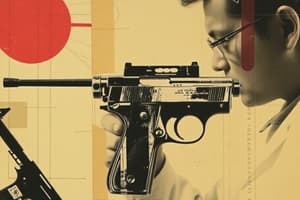Podcast
Questions and Answers
What is the purpose of rifling in firearms?
What is the purpose of rifling in firearms?
- To decrease the accuracy of the firearm
- To increase the rate of fire
- To impart stability to the bullet (correct)
- To prevent the bullet from exiting the barrel
What is the relationship between barrel length and firearm accuracy?
What is the relationship between barrel length and firearm accuracy?
- Long barrel and more gunpowder provide high velocity, stability, and range, leading to greater accuracy (correct)
- Long barrel decreases stability and accuracy of the firearm
- Shorter barrels provide higher accuracy due to better maneuverability
- Barrel length has no impact on firearm accuracy
How is the caliber of a firearm bore measured?
How is the caliber of a firearm bore measured?
- By the weight of the firearm
- By the length of the firearm
- By the color of the firearm
- In hundredth or thousandth of an inch or in millimeters (correct)
What are the components of a rifle?
What are the components of a rifle?
Which method assumes straight line trajectories and is applicable for high velocity, moderate distant shots?
Which method assumes straight line trajectories and is applicable for high velocity, moderate distant shots?
What are the factors involved in trajectory analysis?
What are the factors involved in trajectory analysis?
What is used to detect muzzle-to-target distance of lead?
What is used to detect muzzle-to-target distance of lead?
What is the product of the detonation of gunpowder used in the Griess test?
What is the product of the detonation of gunpowder used in the Griess test?
What is used to form a diazonium salt in the Griess test?
What is used to form a diazonium salt in the Griess test?
What can be identified by a combination of morphology (spheroidal shape) and chemical composition (lead, barium and antimony from primer vaporization)?
What can be identified by a combination of morphology (spheroidal shape) and chemical composition (lead, barium and antimony from primer vaporization)?
What should be examined to determine if the suspect's tool caused markings?
What should be examined to determine if the suspect's tool caused markings?
What should not be done when experimenting with the angle of use and portion used?
What should not be done when experimenting with the angle of use and portion used?
What should be considered when determining the type of tool used?
What should be considered when determining the type of tool used?
What is used to detect GSR patterns on dark/patterned targets?
What is used to detect GSR patterns on dark/patterned targets?
What should not be attempted at the scene when dealing with suspected toolmarks?
What should not be attempted at the scene when dealing with suspected toolmarks?
Which component is not typically found in a cartridge?
Which component is not typically found in a cartridge?
What is the purpose of single-base and double-base primers in ammunition?
What is the purpose of single-base and double-base primers in ammunition?
What method is used for examining bullets and cartridge cases?
What method is used for examining bullets and cartridge cases?
What firearm feature contributes to its uniqueness in creating bullet striations?
What firearm feature contributes to its uniqueness in creating bullet striations?
What does current computerized firearms evidence analysis include?
What does current computerized firearms evidence analysis include?
Flashcards are hidden until you start studying
Study Notes
Forensic Firearms Evidence Analysis
- Cartridges with the same bore size may contain different ammunition types
- Firearms actions include bolt action, lever action, hinged frame, pump action, and semi-automatic
- Cartridges are the typical unit of ammunition and hold projectiles, propellant, and primer
- Ammunition types include projectiles, propellant, and primer, with different compositions
- Primer types include single-base (nitrocellulose) and double-base (nitrocellulose and nitroglycerin)
- Collection and preservation of firearms evidence involves avoiding contamination and labeling
- Microscopy and comparison microscope are used for examining bullets and cartridge cases
- Striations on bullets and the number and size of lands and grooves are unique to the firearm
- Cartridge case comparisons involve breechface markings and firing pin indentations
- Computerized firearms evidence analysis allows rapid cross comparison of bullets and casings
- Early computerized firearms evidence analysis databases are for screening purposes only
- Current computerized firearms evidence analysis includes reconstructions and trajectory determinations
Studying That Suits You
Use AI to generate personalized quizzes and flashcards to suit your learning preferences.




